Sharlyn J. Lauby's Blog, page 104
January 29, 2019
Employees Become Successful When They Know What Success Looks Like

(Editor’s Note: Today’s post is brought to you by our friends at Kronos , a leading provider of workforce management and human capital management cloud solutions. Kronos was honored for the second consecutive year with a Glassdoor Employees’ Choice Award as one of the Best Places to Work in 2019 . Congrats to them and enjoy the article!)
I know the title of today’s post might seem obvious but achieving it can be harder than it looks. Employee performance is contingent on understanding what good performance looks like. It means the company’s performance standards must be clear. It also means that managers can both articulate and evaluate those standards.
To me, employee performance standards are similar to competencies. Both performance standards and competencies include knowledge, skills, and abilities (KSAs). They’re linked to organizational KPIs (key performance indicators) – a business metric that determines if the company is achieving its goals.
Performance standards help to set expectations and provide consistency. They drive the consumer and employment brand. They contribute to the customer, employee, and candidate experience. Here’s an example: I once worked at a company that said the telephone needed to be answered within three rings. That was the performance standard. Managers were able to communicate the standard and could tell when the standard wasn’t being followed. In addition, employees knew the standard and also recognized when the standard wasn’t being followed.
Now you might be saying, “Sharlyn, that was simply answering the phone. No biggie.” But in the company that I worked for, it was a big deal. The company felt that customers got angrier the longer the phone wasn’t answered. They felt it was a sign of disrespect. So, hearing the phone ring wasn’t a good thing around the office. What was a good thing is that everyone knew the standard and made sure that, if a co-worker couldn’t answer the phone, they would answer it. Managers didn’t have to beg employees to answer the phone. Everyone knew the standard and they followed it.
Managers don’t want to police company policies.
So, where am I going with this? Well, as a human resources professional, I hear from other HR pros on a regular basis that they don’t want to become the company’s police department for dress code policies, missing breakroom lunches, and office drama. HR wants to play a proactive role in helping employees succeed.
In fact, no one wants the job of policing company policies. Including department managers. It’s a waste of their time and company resources. What isa good use of manager time is coaching employees who need support improving their performance. Whether that’s because the employee’s current performance doesn’t meet the company’s standard OR because the employee has the capability of exceeding the standard.
Having managers spend time coaching helps raise overall performance levels and benefits the company’s bottom-line. Unfortunately, over the years, managers have been trained to spend more time learning how to police policies then truly coaching employees. But the good news is that companies can change that.
The key to this transformation of making managers coaches begins with organizations providing the right tools, especially when it comes to clearly understanding and communicating performance standards. I recently had an opportunity to test drive a new solution from our friends at Kronos called Employee Perspectives.
Employee Perspectives uses predictive analytics and artificial intelligence (AI) to analyze the huge amounts of transactional data that organizations creating on a continual basis. By transactional data, I’m referring to general employee data like:
Human Capital Management (HCM) data such as hire date, department, length of employment, and job responsibilitiesWorkforce Management (WFM) information like last shift, next shift, last day off, time off requests, shift swaps
What we’re talking about here is utilizing all the valuable WFM information that typically only gets looked at when we’re calculating accruals, etc. Then add to it the HCM data (i.e.how long the employee has worked for the company, the types of and frequency of trainings and certifications, the last time they received a raise and for how much, when they may get a raise in the future, and how many candidate referrals they’ve submitted, etc.). The result is evidence-based insights into workforce areas such as employee performance, fatigue, succession readiness, and even engagement.
You guys know that I’ve worked with Kronos for a long time. Because of their position in the market as the leader in workforce management, they are uniquely positioned to capture and analyze this data. And with their rapid expansion into HCM, they can be a partner to HR by providing a data-driven approach to traditional employee-centric processes that, while important, are often based on anecdotal evidence. The reason they can do this is because the company’s HR, workforce management, and payroll solutions run on a single, unified database, providing an accurate, real-time view of information.
While the solution does many things, my big takeaway was its ability to define company performance standards, which is the key for employee success.
Customized performance standards change performance.
Now that I’ve explained what Employee Perspectives does, here’s how it works: Organizations use Employee Perspectives to identify KSAs. The KSAs are grouped into competencies and assigned a weighted percentage. The competencies can then be used to discuss performance standards. This can be done for both salaried and hourly employees. In talking with Kronos, they believe this focus will help organizations extend high quality performance discussions throughout the entire organization.
In the demo that I participated in we identified safety incidents and fatigue as being KSAs which impact performance. Those two KSAs were grouped under a competency we labeled “risk awareness”. And we assigned fatigue as 60 percent of the competency and safety incidents as 40 percent.
The idea here is that managers and employees understand performance involves being risk aware. The company has some performance standards related to being safe on the job. Managers and employees are aware that fatigue can lead to safety incidents, so the manager and employee will regularly discuss wellness and well-being. (So, employees don’t come to work exhausted and potentially hurt themselves or others.)
Employee Perspectives allows organizations to have these focused performance conversations with employees throughout the employee life cycle – during recruiting, orientation, onboarding, as well as one-on-one meetings. The manager has the responsibility of discussing performance standards and employees become personally accountable for their performance.

Finally, as a bonus, human resources departments can watch for employee performance trends in Employee Perspectives. If they need to propose a learning and development intervention, then they are positioned to take a proactive approach. Again, the whole notion of policing performance is dealing with things after they happen. Employee Perspectives is about taking a proactive approach to employee performance through the definition of performance standards.
Employees want to perform. Give them the tools.
Let’s face it – performance is important. Organizations want employees to perform at a high level. Managers want that too. And guess what, employees also want it so they can succeed in their roles. We need to give managers and employees the tools to identify and talk about successful performance. That happens when managers become coaches.
If you’re organization is trying to figure out how managers and HR can spend more time proactively coaching employees on performance, take a moment to demo the Employee Perspectives solution. The customization feature is really a game changer. Organizations have the ability to focus on those performance factors that matter the most to their business. Isn’t that what every company wants? Employees working on those things that matter most.
P.S. I know that I’ve focused on employees and performance in today’s post, but Employee Prescriptives can do much more than that. HR leaders can use it to proactively address a variety of workforce trends like employee engagement, absenteeism, and flight risk/turnover. All factors that contribute to performance, but they can be examined individually. Consider setting up a demo so you can see it yourself.
The post Employees Become Successful When They Know What Success Looks Like appeared first on hr bartender.






January 27, 2019
10 Ways to Be a Better Team Player

I’ve been recommending the Harvard Business Review article “Collaboration Overload” a lot lately. It’s a good read if you haven’t already read it. My big takeaway from the piece is that employees spend more time collaborating than ever before. And that the skills it takes to be a good collaborator are different than being a HiPo contributor. So maybe organizations need to spend more time helping employees become better collaborators.
That being said, I think one of the first things it takes to become a better collaborator is being a better team player. Here are 10 things that come to mind:
Communicate! I know, I know. Communication always shows up on these lists. But effective communication with the team is important. It’s how we present ideas, provide feedback, and ultimately accomplish goals. One aspect of communication that’s particularly important is empathy. Being a good team player means having empathy for others and using it when delivering messages.Balance the positive and negative. I’m one of those people who believes that life isn’t always positive nor is it always negative. Knowing when to be the skeptic and when to be the cheerleader is important. We run the risk stopping momentum if we don’t know how to motivate people. I’m not saying don’t present your concerns but figure out how to do it where the other person doesn’t lose their zest for the project. Think about work flows. Sometimes one of the most valuable things a team player can do is explain how things get done in their department or the company. Not always what the policy is – although that can be helpful too – but how things really get done. Being a good team player means not only knowing how things work around the office but being able to suggest new and better ways of doing things.Be organized. I realize that I’m a ridiculously organized person but there’s nothing worse than sitting in a meeting watching someone fumble around for stuff. It’s painful for others to watch and for the person being watched. Disorganization can be confused for not caring and being respectful of others’ time. When meeting with other members of the team, take a few moments to prepare. Don’t assume that everything is immediately accessible.Work outside of your department, company, and industry. If you work in a perfectly cohesive team right now, congratulations! Your working situation as a team player is rare. And dare I say, not helping you get better at team development. Working on a team can be challenging, frustrating, and downright hard. It can also be incredibly fulfilling, educational, and lots of fun. Look for opportunities to work on teams that will give you both.Set the right priorities. High performing teams accomplish their goals because everyone on the team has the same priorities. Are your priorities the same as the rest of the team? If they’re not, ask yourself “Why?” Do you need to have a conversation with the team leader about your concerns? Are you the right person to be on the team? But if you haven’t bought in to what the team is doing, then you owe it to yourself and the team to find out why.Meet your deadlines and keep your promises. Your credibility as a member of the team is important. The quickest way to lose your cred is by not being a person of your word. I understand that stuff happens but that’s no excuse for leaving the team waiting. Renegotiate your commitments when necessary. The team wants to count on you because, at some point, you’ll need to count on them.Understand your influence. Everyone has power and influence. Everyone. It’s important to realize that and use your influence for positive outcomes. Not only is it bad to use your power for the wrong reasons but it’s equally bad to not use your influence when you could. In those situations, the rest of the team knows that you can change a situation and you didn’t step up. Have fun. Whenever I see lists, have fun is always seems to be the final one. Let me suggest that being a part of a team should be fun. Yes, there will be tough days. But you really should have more fun days than tough days. The team should find ways to have fun, laugh, and celebrate their successes. Building some kind of bond with the rest of the team will help everyone become a better team player.Respect others even when you disagree with them. I read somewhere that “Dream teams are made up of diversity not sameness.” No matter what happens on the team, the individuals on the team should be treated with respect. That doesn’t mean you can’t disagree. In fact, the team might need to disagree to produce their best work. But you can raise questions, show concern, and not agree with respect.
Even employees who are considered “individual contributors” have to work on teams. We all must have the ability to work with others. And it takes effort to do that. I find that lists like these are good reminders for me about all of the things I need to do to be a good team player. Because it’s hard. Somedays I’m very focused on being organized. Then somedays I’m focused on deadlines. It happens. The good news is if we’re all focused on being a good team player, then the other members of the team are too.
Image captured by Sharlyn Lauby after speaking at an event in New York, NY
The post 10 Ways to Be a Better Team Player appeared first on hr bartender.






January 25, 2019
Managers: Ask Employees to Give You Feedback – Friday Distraction
(Editor’s Note: Today’s post is brought to you by our friends at Kronos , a leading provider of workforce management and human capital management cloud solutions. Want to create an inspired workforce? Check out Kronos CEO Aron Ain’s new book “ Work Inspired: How to Build an Organization Where Everyone Loves to Work ”. Enjoy the article!)
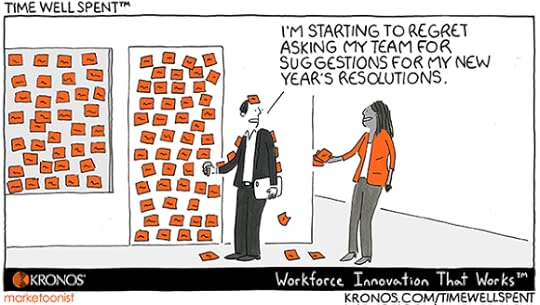
Years ago, I worked with a CEO who, every year, asked the company to give him a performance review. Granted, they were a small company, but the point was that he asked several dozen employees to rate his performance. He felt it was fair. Every other employee got a performance review, why shouldn’t he?
I was reminded of that CEO when I saw this Time Well Spent from our friends at Kronos. While the cartoon deals with New Year’s resolutions, how many managers ask their employees for feedback about their performance? If a manager isn’t doing this, maybe they should be. There are a few opportunities where it makes sense.
ONBOARDING: Managers should be asking employees how they like to work and sharing their work preferences as well. I have to admit that my effectiveness as an employee dramatically increased once I figured out my boss’ work style. It allowed me to pitch ideas at the right moment, and that is important.
TRAINING: It’s possible that employee conversations could highlight the need for manager training. Are managers well equipped to support employees? Managers need to be able to identify their own professional growth needs. In addition, they need to feel comfortable asking for development.
ONE-ON-ONE MEETINGS: Managers can ask employees, “How can I support you to achieve your goals?” It’s not enough just to set goals with employees. They need to feel like the company will do what’s necessary for the employee to achieve those goals.
PERFORMANCE: Speaking of employee support, managers might need to set goals that are directed at supporting employees. It’s possible that a manager might need to coach an employee through an issue. Or they need to learn a process to better support an employee.
Managers can avoid asking employees for feedback, but it only hurts them in the long-run. Managers have three groups of people they work with every day: their bosses, their peers, and their teams. There might be some thought that the only people you need to make happy are the bosses. But the reality is, a manager who can’t keep employees will attract the attention of the bosses (and not for the right reasons).
And employees who don’t feel they can give their manager feedback, will go find another manager that they can.
The post Managers: Ask Employees to Give You Feedback – Friday Distraction appeared first on hr bartender.






January 24, 2019
Bookmark This! 2019 Politics Edition
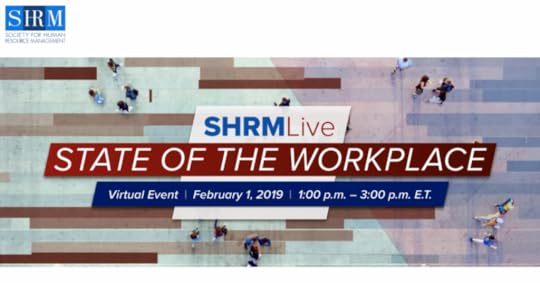
Before you totally dismiss today’s article because of the word “politics” in the title . . . I hope you will hear me out.
I know none of us enjoys getting up in the morning and hearing that the U.S. government is still shut down. That being said, we can’t simply tune it out. Our current representatives – meaning both Democrats and Republicans – are proposing new laws every single day. Some of those bills impact our work and organizations. As human resources professionals, we need to continue to monitor the legislative landscape to make sure that we stay current with what’s happening in Washington, D.C.
If you haven’t heard about it already, the Society for Human Resource Management (SHRM) is hosting a live webcast on Friday, February 1, 2019 from 1-3p Eastern on the “State of the Workplace”. The session will talk about the current legislative landscape. As human resources professionals, we need to stay on top of what’s happening so we can advise our organizations. You can view the full agenda and register on the SHRM website.
Another SHRM resource that I use on a regular basis is their Policy Action Center. This site allows me to stay on top of federal and state issues. I can also write my legislators from the site (SHRM has pre-written letters that you can customize).
Speaking of writing your legislator, I’m still a fan of Resistbot, a chatbot that allows you to send messages to your Senator, Representative, and Governor about issues that are important to you. Don’t let the word “resist” deter you from using this communication tool. It’s very easy to use and great when you have a short message that you would like to convey.
Countable is another site that allows you to write your legislator. I especially like their daily updates that tell me what legislation is up for vote in Congress. It will also tell me how my legislators voted on bills.
And if you’re saying to yourself, “Sharlyn, I know I should be paying more attention to politics, but I just can’t even…” I get it. Check out this Lifehacker article from last year. I think it’s still relevant today. “How to Stay Politically Active When Everything is Overwhelming”
One last thing I want to share when it comes to today’s politics. Personally, I’ve found that the way the message is presented is important. No different than in the business world. The way we hear about a new idea or a proposal can impact the way we process it. Over the past couple of years, I’ve become a fan of “The Skimm”. It’s an electronic newsletter that covers politics – both nationally and globally. It also has a little pop culture. One feature I like very much about The Skimm are their guides. So, if I haven’t been paying attention to an issue then all of a sudden I’m saying to myself, “I need to read up on this.” The Skimm helps me get up to date with very casual, conversation writing.
I’m not here to tell anyone their politics. But I am saying “Don’t stop being involved.” We need legislative advocacy in areas that impact our personal and professional lives. So, find the websites, newsletters, chatbots, etc. that give you the information you need to stay informed and help you voice concerns. I think it’s very exciting to have so many new and interesting ways to stay connected with politics.
The post Bookmark This! 2019 Politics Edition appeared first on hr bartender.






January 22, 2019
Company Culture: Tell Employees They Own It

There are lots of articles on the interwebs about company culture: the importance of it, the need to sometimes change it, and how to create a memorable one. There are also plenty of articles about HR or senior management being the creators and keepers of company culture.
It was very refreshing to hear JetBlue talk about company culture at the last WorkHuman Conference, powered by Globoforce. They tell employees during onboarding that they (the employees) are the keepers of company culture. In addition, they tell employees how to be a good culture keeper. It involves these four key principles (you could also think of them as values):
Own it. Employees are expected to support and embrace the mission of the company. Protect it. Employees will hold themselves and others accountable for doing the same.Share it. Employees recognize, reward, and share stories about he company culture.Grow it. Employees understand that if they do the first three, then this one will happen.
On the surface these might seem quite simple, but that’s the point. They’re easy to convey, easy to understand, and easy to do. These principles can be incorporated into interviews, onboarding, training, and performance management.
Now, I’m not suggesting that everyone go out and copy JetBlue’s culture statements. It’s their culture and you shouldn’t duplicate it. But it does raise the question, in your organization, who owns culture? And do the people who own culture know it? Furthermore, do the culture keepers of your organization get the resources they need to properly do their job?
Whether it’s senior management, human resources, or all employees, it’s important to communicate who will be responsible for keeping the company culture alive and thriving. If they don’t know, how can they do their part? It does make me wonder if companies struggling with their culture are really struggling because they haven’t defined who owns it and communicated that message.
P.S. Just a reminder that registration is open for WorkHuman 2019! The event will be held March 18 – 21, 2019 in Nashville, TN at the Gaylord Opryland Resort. Several speakers have already been announced including award-winning actress Viola Davis, so check out their website for details. And if you use the registration code WH19INF-MFA, you’ll get a $100 discount. It’s always a fantastic event. Hope to see you there!
Image captured by Sharlyn Lauby after speaking at the SHRM Annual Conference in Washington, DC
The post Company Culture: Tell Employees They Own It appeared first on hr bartender.






January 20, 2019
5 Factors That Connect Performance and Compensation – Ask #HR Bartender
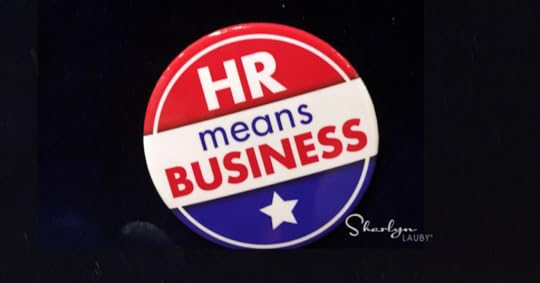
I received this comment/question a few months ago asking about the relationship between compensation and performance. It’s a common question and concern.
I’d love to hear more about the ways a company can focus on performance apart from the obvious commission-based salaries and the monthly goals to achieve. I know it seems like THE question to be answered, but it would be great to have some of your insights on that question. Keep up the good work.
First, thanks for the very kind words. I believe there is a link between performance and compensation – whether you’re in sales or not. Employees expect to be paid well when they perform well. And even in industries where the perks are super cool, employees expect a certain base salary and benefits.
It can be a challenge to separate the two. Especially if the organization has engrained in their culture that high performers make the most money. Unfortunately, in this scenario, there are things we don’t know. For example, what type of total rewards package do employees currently receive? How are employee goals established and measured? We also don’t know what industry we’re talking about. Those factors matter.
While I can’t offer up any specific solutions, we can look at the factors that connect compensation and performance, with the idea that changes in these areas can prompt a greater shift toward performance.
For example, when I worked in hotels, sales managers had goals they needed to meet. But remember – hotel rooms are a finite quantity. Sales managers were compensated for their individual results as well as team results. That’s because sometimes a sales manager didn’t book a piece of business because another sales manager was presenting business over the same dates that would net the hotel more revenue.
And when I worked in the airline industry, we didn’t have sales people as much as we had marketing people. The reservations department didn’t ask, “What sales manager helped you with this booking?” So, sales/marketing employees didn’t have sales goals in the traditional sense. Different industries, different ways of establishing compensation.
But there’s one other factor we need to consider: the company’s performance management process.
I read an article recently in TD Magazine called “No Quick Fixes”. In the article, author Ben Eubanks discusses the future of performance management. One aspect he covers is how to handle employee compensation without performance appraisal ratings. It’s a good read and I hope you will check it out. It made me realize that as we’re thinking about performance and compensation, our performance management processes impact employee salaries and bonus structures.
So, organizations looking to address the shift from compensation toward performance have to look at their current practices.
What is the product or service that the company provides? How are sales tracked and measured?What is the current employee compensation package?How are employee goals set? Who is involved in the process?When and how do employees learn about their performance? And their compensation?
If organizations want to focus more on performance and less on pay-for-performance, that’s fine. It makes total sense. But I’m not sure that we can tell employees to focus on performance (not money) then dangle the carrot. It’s a mixed message that might be confusing.
Image captured by Sharlyn Lauby after speaking at the SHRM Annual Conference in Washington, DC
The post 5 Factors That Connect Performance and Compensation – Ask #HR Bartender appeared first on hr bartender.






January 18, 2019
Find and Train Your Replacement Through Succession Planning – Friday Distraction
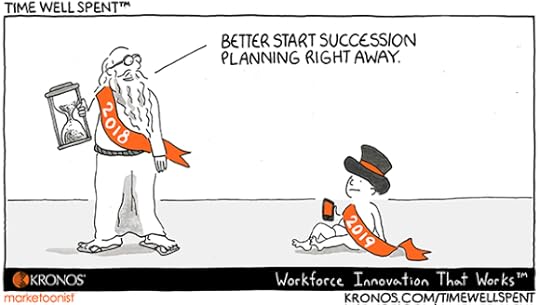
The holiday season is behind us. That being said, this New Year’s themed Time Well Spent from our friends at Kronos shares a message we should embrace all year long. Organizations need to dedicate resources toward replacement and succession planning.
I know many companies don’t like to make this level of commitment to employees. They don’t want to say, “Joe, we’d like for you to become our next vice president of finance.” Because what happens if Joe does something crazy and the company changes their mind? Organizations figure if we don’t commit to Joe, then we don’t put ourselves in that position.
But here’s the deal. What happens if Joe comes into your office next week and resigns? Or decides to retire? Companies need to prepare for these issues. Here are a few things to consider:
Organizations need to think about knowledge management. Let’s put the succession planning argument to the side for a moment. With unemployment at record lows, employees are testing the job market. Companies need to think about their key employees and the work they do. What happens if those employees decide to leave? Companies should be thinking about cross-training to make sure their history and knowledge is passed along.
Internal talent pools can be a viable alternative to replacement and succession planning. If the only hold-up to talent planning is committing to employees, organizations can create talent pools. These employee “pools” create opportunities for development without specific job commitment. Using the example above, the company can tell Joe, “You have a future with us. We don’t know all the details, but we’d like to start developing you for the future.”
If companies are worried about employee retention, then they need to do something about it. I’m going to deliver some tough love here. Companies that want to engage and retain employees need to take actions that will do so. It’s not logical to expect employee retention without competitive wages, training and development, and positive workplace relations. Telling employees they have a future is part of that.
The conversation about succession planning is about more than avoiding one unpleasant conversation with an employee. It’s about talent management. Organizations will not be able to achieve their talent management goals if they don’t think holistically about current and future talent. That includes training, development, knowledge management, and talent planning.
The post Find and Train Your Replacement Through Succession Planning – Friday Distraction appeared first on hr bartender.






January 17, 2019
Employee Perks: Should Companies Offer Free Food [POLL]

I ran across this article the other day on LinkedIn about “A Once-Rare Office Perk Takes Hold”. It’s about a growing number of companies offering free or discounted food to employees. Interesting read. But I must admit that when I see these articles, I don’t have the same reaction of “Wow! Companies offering free food!” because I worked in industries where a free meal was the norm.
Offering free meals as part of employee perks is definitely a nice thing to do. Especially when employees:
Make minimum wage or just above itAre scheduled wacky hours, where there might not be an option to go out for foodDon’t have access to an employee breakroom, where they could refrigerate or reheat their mealWork in expensive cities where the cost of going out is prohibitive
Organizations that include meals in an employee perks package have to think about what types of food and the nutritional value of the food that they will offer to employees. I can tell you from experience that “menu complaints” were a regular workplace issue. Also, how those meals are going to be prepared (i.e. staff, sanitation, costs, storage, etc.) I recently saw in the newspaper a company’s employee breakroom receive a warning from the health department for sanitation. (Can’t imagine that helps the company’s recruiting and retention efforts.)
So, what do you think? Is free food really the new “must-offer” perk? I hope you’ll take a moment to complete one (or both) of these survey questions.
AS A COMPANY - - what do you think of including in the employee perks package free food?We offer free food to our employees, and they love it!We're considering offering free food to employees as a perk.We have no desire to offer free food as one of our employee perks.Vote
I think it will be interesting to show these results side-by-side. Again, I hope you’ll take the time to answer and share the poll with your networks. I’ll post the results in a couple of weeks.
Organizations are looking for ways to stand out in the crowd. And free food could be one of those ways. While I don’t know that free food creates employee engagement, it might set a company apart from the competition. I can’t wait to hear what you have to say on this one! Thanks.
The post Employee Perks: Should Companies Offer Free Food [POLL] appeared first on hr bartender.






January 15, 2019
6 Ways to Improve Your Business Acumen
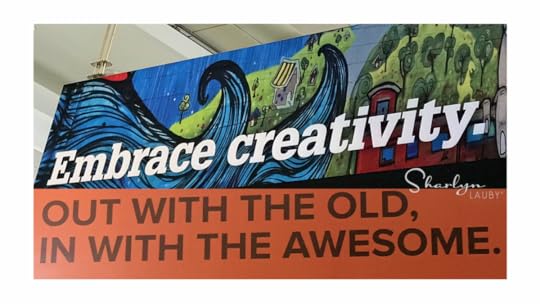
One of the behavioral competencies in the Society for Human Resource Management (SHRM) competency model is business acumen. This should come as no surprise to anyone. It’s important to know the business, be able to talk about it, and make decisions to help the business grow.
But honestly, it’s hard to develop business acumen. Oh sure, a lot of people throw business buzzwords around like “growth mindset” and “blue ocean strategy” but do they really know everything those terms mean? In today’s business world, new concepts are being developed all the time. It’s a challenge to stay on top, especially when your plate is already full of work.
Personally, I find it helpful to take inventory of the things I’m doing to stay on top of business. I love lists that remind me to step back and just get focused. So, here’s a list of suggestions that can help build business acumen.
Read (and listen to) the right stuff. I’ve discovered an electronic newsletter called “Morning Brew” that helps me stay on top of business news. Trust me, I hate junk emails as much as the next person, but this isn’t junk. This Monday-Friday enewsletter provides a stock market overview and some commentary about the business headlines of the day. What I really like is the casual, conversational tone. Business acumen doesn’t have to be boring or stuffy. Develop a business book library. Laurie Ruettimann has put together an HR Book Club. You can also check it out on Facebook. To me, the success of a book club lies in the book selections. She’s doing a great job of curating book selections that stretch our minds from an HR and business perspective. The other thing I love about this book club is, if you don’t want to read the book selection, Laurie encourages you just to read something. So, if you’re ready to tackle that pile of books you have on top of your filing cabinet, this group is for you. Learn how your organization makes and spends money. If you haven’t bought your controller a cup of coffee lately and asked about the profit and loss statement, now might be a good opportunity to do so. Years ago, I did just that during onboarding and it was one of the best hours I’ve ever spent on my career. The good thing is there’s no rule that you’re only allowed to do it once. Consider scheduling coffee time with your controller right before budget time too.Join your professional association. I’m not here to tell anyone which professional organization(s) to belong to. Everyone needs to figure that out on their own. But I do believe it’s valuable to be a member of a professional organization. And let me add that I feel it’s important for individuals to get involved. Volunteer! Not only will you make friends, but you will learn from your colleagues. Part of developing business acumen includes developing a professional network. Step out of your regular responsibilities. The next time the boss is looking for a volunteer, consider raising your hand. Getting involved in project teams can help you 1) learn new knowledge and skills 2) build new working relationships and 3) get noticed by the organization. I know your calendar is already full. These types of extra assignments might be worth it. Both from a learning perspective and your long-term career development. See if you can squeak out a little bit of time to make it happen. Know your customer. When I talk about customer here, I’m not referring to employees. Do you know who the top ten customers are for your organization? Not just their names, but do you know what they do? Years ago, I had the chance to go on some customer calls with the sales team. Very valuable! If you’ve never done it, consider asking a sales manager if you can tag along. You’ll learn a few things and I’d say that the sales department will be happy you did.
Over time, I’ve come to realize that business acumen isn’t something you learn once and you’re done. Business acumen is changing all the time. Yes, it’s true that terms like profit and EBDITA haven’t changed. We have new terms like blockchain, disruption, and vlogger. If you want to be a contributor, you have to know how to really talk business.
The post 6 Ways to Improve Your Business Acumen appeared first on hr bartender.






January 13, 2019
Is Your Organization Humble
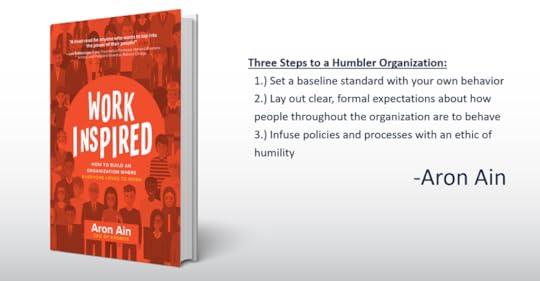
I want to tell you about an organization. Think of it as a case study. It’s a private company with over $1.4 billion in revenue and nearly 6,000 employees globally. Been in business since 1977 and is regularly recognized as a best place to work both in its industry and headquarters location. I think we would agree that this is a very successful company. And one of its core values is humility.
Have you guessed what company I’m writing about? If you said Kronos, then you’re right.
I’ve had the privilege of working with Kronos for many years. First in my Corporate life as a customer of its products and now as a blogger and consultant. I’m honored to have interviewed members of the company’s senior management team on this blog. But I must say “It’s about time!” that finally, after all these years, Kronos CEO Aron Ain has put the secret to the humble company’s success down on paper.
 Kronos CEO Aron Ain
Kronos CEO Aron Ain“WorkInspired: How to Build an Organization Where Everyone Loves to Work” is the story of Kronos. How the company started and where the company is today. What I love about this book is what I love about Kronos – it really is a humble organization. In fact, Ain writes about humility being a company value.
I’m not going to give the book away – you definitely need to pick up a copy and read it for yourself. But I thought his comments about humility were particularly appropriate and create a takeaway for any organization.
Companies can change their culture. Ain talks about humility becoming a company value during a time when the organization was experiencing a lot of change. Personally, I think there are times when organizations forget that as the company is changing, leadership needs to make sure that the company culture and values align with the change.
Define what values mean. Kronos defined humility as “assuming positive intent”. It’s important when the organization establishes values that those values are clearly defined. Don’t make the assumption that every employee holds the same meanings for words. Give employees examples of behaviors that demonstrate a core company value.
Humble isn’t a wimpy word. Ain and the Kronos leadership team make sure that employees understand that humility and “bold” aren’t mutually exclusive terms. Organizational values need to be able to work in concert with each other especially in industries where innovation and speed drive profitability.
Always be positive. Even when things go wrong. Kronos uses humility as a way for employees to hold themselves and others accountable. Will stuff go wrong? Sure, but their expectation is that everyone will model positive behaviors which will benefit working relationships and the company.
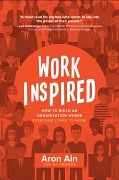
Now you might be saying to yourself, should we copy the Kronos culture? And the answer is no. But, if your organization is looking for some creative inspiration, what better place to get it than from another well-respected organization. Or get a confirmation that you’re doing the right things.
For HR professionals who want some insight into how a CEO thinks, this is a book written by a CEO. There’s no shortage of business talk. But if you’ve ever spent 5 minutes with Aron Ain then you know he’s in the people business. And this book is a great example of how human resources has the role of business partner and what they’re able to do.
The post Is Your Organization Humble appeared first on hr bartender.






Sharlyn J. Lauby's Blog
- Sharlyn J. Lauby's profile
- 10 followers



